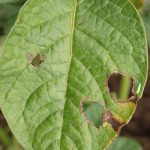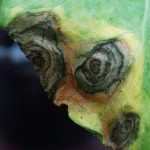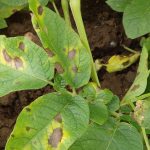Polish name: Potato alternariosis
English name: Early Blight / Target Spot
Kod EPPO: ALTESO, ALTEAL
Perpetrators of the disease:
Mushrooms of the genus Alternaria:
- A.solani, EPPO Code: ALTESO
- A.alternata, EPPO code: ALTEAL
Ggallery
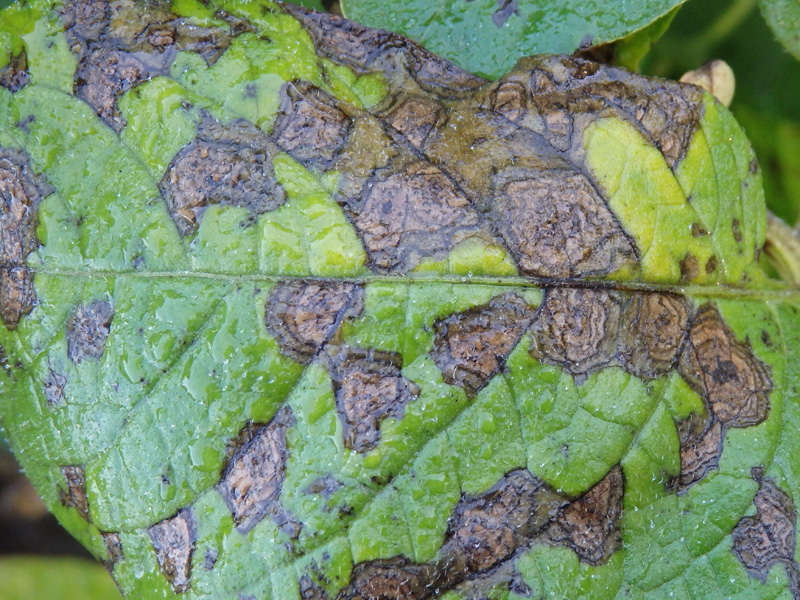
Potato alternaria. Characteristic appearance of necrotic spots
(photo: J. Osowski)
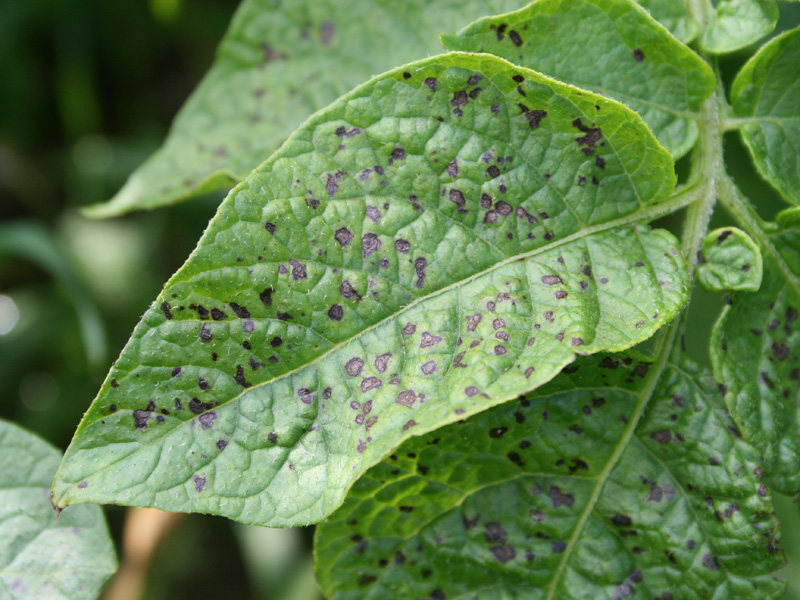
Potato alternaria. Characteristic appearance of necrotic spots
(photo by S. Wróbel)
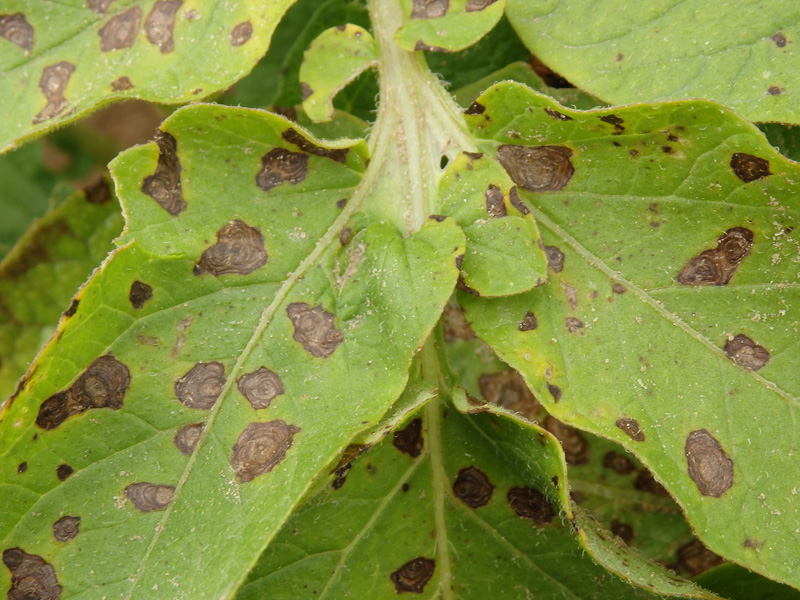
Potato alternaria. Characteristic appearance of necrotic spots
(photo: J. Osowski)
- Alternarioza ziemniaka. Wykruszanie się tkanki wewnątrz nekrozy (fot. J. Osowski)
- Alternarioza ziemniaka. Charakterystyczny objaw choroby – chloroza dookoła nekrozy (fot. J. Osowski)
- Alternarioza ziemniaka. Charakterystyczny objaw choroby – chloroza dookoła nekrozy (fot. J. Osowski)
Characteristics and description of the pest
Due to climate change, fungi of the genus Alternaria, the cause of alternaria, are gaining more and more importance in potato cultivation. There is an ongoing debate around the world as to which species of fungus is responsible for causing the symptoms of the disease. In many European countries (the Netherlands, France, Sweden), A. solani is considered to be the culprit of alternaria. In others (Germany, Poland) it is believed that two species of fungus are responsible for its development: A. solani – the cause of dry leaf spot and A. alternata – the cause of brown leaf spot.
Symptoms of plant infection with fungi do not differ morphologically with the development of the disease, therefore their occurrence is assessed jointly on potatoes – as alternaria. Both species of fungus are common and occur in all areas of potato cultivation, especially those with high temperatures with alternating periods of dry and humid weather. The fungi survive from season to season as mycelium or spores in infected tubers, or in soil, on plant debris. According to recent studies, after using more precise molecular methods for diagnostics, it is recognized that the disease may be caused by additional species of the genus Alternaria, such as A. tomatophila, A. tenuissima, A. infectoria and A. arborescens and A.grandis.
Potato yield losses caused by alternariosis vary depending on the region of its occurrence. In the central-eastern regions of the USA, alternariosis is considered to be the most serious chronic disease of potatoes (more important than potato blight), and its perpetrator (A. solani) – as an endemic species. In Poland, yield losses caused by the development of alternaria in unprotected plots in field experiments have ranged from 6-45% in recent years. In the years 1998-2006, in cooperation with the Inspectorate of Plant Health and Seed Inspection, an assessment of the occurrence of alternaria in potato plantations in Poland was carried out, showing that the disease was common in most production fields, on average on 85.5% of the observed crops.
Alternariosis is a disease associated with a warm and dry climate, short-term, abundant rains and light soils. Other factors contributing to the development of the disease are also biological factors dependent on the pathogen itself, i.e. a very large genetic diversity within the species, giving a great adaptation potential, and the ease of transmission of the fungus spores by the wind. Alternaria is a typical necrophyte. Its occurrence is favored by all factors contributing to the weakening of plants, i.e. the aging of potato plants, low organic matter content in the soil, low nitrogen fertilization, and infections with other pathogens. Potatoes infected with certain viruses (PVY, PLRV and PVX) are more susceptible to alternaria.
Symptoms of paralysis
The first symptoms of alternaria on the leaves usually appear in June and early July. Typical spots appear on the leaves: dark brown, round or angular (limited by leaf veins), 3-15 mm in diameter, usually with a characteristic concentric zoning (photos 1A, 1B, 1C). Very often the leaf tissue surrounding the stain undergoes chlorosis (Photos 2A, 2B). Infected, necrotic tissues become dry and brittle, often chipping (photo 3). On the lower side of the leaf, along the entire surface of the necrosis, one can observe not very profuse dark mycelium and fungus spores. Sporation takes place only on dying or dead tissues. The symptoms of the disease may vary slightly depending on the affected variety. Most often they are smaller or larger concentric brown spots on the potato leaves, resembling a shooting target. Depending on the reaction of the potato variety, the stains may be very fine and very numerous or less numerous and larger. The disease also attacks potato tubers in the form of shallow gray-lead depressions 1-3 mm deep. The eyes in these places die. Although tuber necroses are not deep, they pose a great threat to the health of the crop. They facilitate the penetration of many fungi from the soil into the tubers, causing internal rot that would not be able to reach the tubers through a healthy, unbroken skin (eg Fusarium, dry rot culprits).
Protection methods
Combating alternaria is quite difficult. Conservation strategies include cultivar resistance, fungicide use, optimal agrotechnics and harvesting when tuber skin is mature.
The recommended agrotechnical procedure is aimed at reducing the sources of infection by using crop rotation, removing crop residues from the field, as well as using healthy seed potatoes for planting.
The genetic resistance of varieties can also be an important element. Although potato resistance to alternariosis has not been determined, many years of field observations indicate that the more resistant cultivars include: Augusta, Gracja (very early and early) and Passion and Syrena (medium late and late). Other cultivars show high resistance to A. solani and susceptibility to A. alternata, e.g. Innovator and Skawa. It is generally accepted that later varieties are less susceptible to alternariosis than the early ones.
Since the development of pathogens of the genus Alternaria is favored by all elements that weaken and “stress” the host plants, an important element of protection will be treatments strengthening the condition of the plants, i.e. proper nitrogen fertilization, foliar feeding of plants and irrigation in periods of prolonged drought.
Disease control also consists in spraying the susceptible varieties with one of the registered fungicides. The first treatment usually begins when the first symptoms appear. Products from the group of dithiocarbamates are the most useful for fighting alternaria, especially those containing mancozeb (the zinc content of this active substance strengthens potato plants, and at the same time enhances their defensive reaction). Products from the group of diphenoconazoles and strobilurins are also recommended. Unfortunately, strobilurin-resistant fungal isolates of the genus Alternaria have already been discovered in Europe and the USA. Therefore, when using preparations from this group (e.g. azoxystrobin, pyraclostrobin and others), one should remember about the anti-immune strategy in chemical protection. It consists, inter alia, on limiting their use in years with a strong infectious pressure of the pathogen (hot years with periods of drought and short-term rainfall), limiting the number of treatments performed with these fungicides (up to 2 per season), using full, registered doses, limiting the time of their application (not they should be used at the end of the growing season as pathogen resistant forms may be carried over to the next year with the seed potatoes).
Compiled by: prof. dr hab. Józef Kaps

